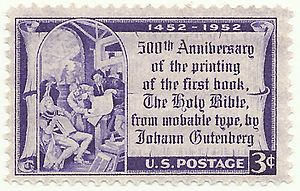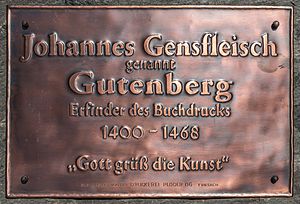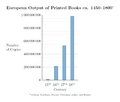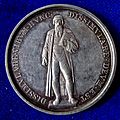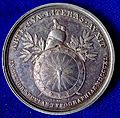Johannes Gutenberg facts for kids
Quick facts for kids
Johannes Gutenberg
|
|
|---|---|
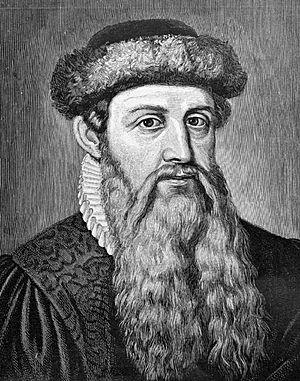 |
|
| Born |
Johannes Gensfleisch zur Laden zum Gutenberg
c. 1398 |
| Died | February 3, 1468 (aged about 68) |
| Occupation | Engraver, inventor, and printer |
| Known for | The invention of the movable-type printing press |
Johannes Gutenberg (born around 1398 – died February 3, 1468) was a German inventor. He was a blacksmith, goldsmith, and printer. Gutenberg brought printing to Europe using his special printing press.
His invention used mechanical movable type printing. This started a huge change called the Printing Revolution. Many people believe his printing press helped begin the modern period of human history.
Contents
Gutenberg's Printing Press
In 1439, Gutenberg was the first person in Europe to use movable type. This meant he could arrange individual letters to print words. He used special oil-based ink and molds that could be adjusted. He also used a wooden printing press.
Gutenberg found a way to make many copies of these movable types quickly. This made printing books much faster. His printing technology quickly spread across Europe and then the world.
Before Gutenberg's press, books were all handwritten. This made them very slow to create and super expensive. Only rich people could afford to buy books. Gutenberg's invention allowed him to make many books for less money. This meant more people could buy books. It also helped more people learn to read, which increased literacy and education.
Gutenberg's press was very important for many big changes in history. These include the Renaissance, the Protestant Reformation, the Age of Enlightenment, and the scientific revolution. His most famous work is the Gutenberg Bible. It is known for how well it was made and how beautiful it looks.
In the 1800s, new steam-powered presses replaced Gutenberg's hand-operated press. These new machines allowed printing on a huge scale. Printing became a major industry around the world.
Later Life and Legacy
In 1462, there was a big fight in Mainz called the Mainz Diocesan Feud. The city was attacked, and Gutenberg had to leave. He was an old man by then and moved to Eltville.
In January 1465, Gutenberg's amazing work was recognized. He was given the title Hofmann, which means gentleman of the court. This honor came with money and food, all tax-free. He might have moved back to Mainz around this time, but we are not sure.
Gutenberg died in 1468. He was buried in a church in Mainz. Sadly, this church and its cemetery were later destroyed. So, Gutenberg's grave is now lost.
In 1504, a professor named Ivo Wittig mentioned Gutenberg as the inventor of typography. The first portrait of Gutenberg appeared in 1567. It was likely an imagined picture, not a real one.
Gutenberg is seen as one of the most important people in human history. In 1999, the A&E Network named him the most influential person of the second millennium. In 1997, Time–Life magazine called his invention the most important of the second millennium.
Johannes Gutenberg Quotes
- "Give me twenty-six soldiers of lead and I will conquer the world."
- "It is a press, certainly, but a press from which shall flow in inexhaustible streams. Through it, God will spread His Word."
- "Religious truth is captive in a small number of manuscript books, which guard the common treasure, instead of diffusing it. Let us break the seal which holds the holy things; give wings to the truth that by means of speech, no longer written at great expense by the hand that wearies itself, but multiplied as the air by an unwearied machine, it may fly to seek every soul born into the world!"
Interesting Facts About Johannes Gutenberg
- Gutenberg's father, Friele Gensfleish, worked in the Mainz mint. Johannes likely learned about making coins as he grew up.
- Johannes had a brother named Friele and a sister named Else. He also had a half-sister named Patze from his father’s first marriage.
- A woman named Ellewibel zur Isernin Thure once accused Gutenberg of breaking a promise to marry her daughter, Ennelin.
- Only 49 copies of the Gutenberg Bible still exist today.
- The last time a complete Gutenberg Bible was sold was in 1978. It sold for $2.2 million.
- Experts now think a complete copy could sell for $35 million at an auction.
Images for kids
-
Gutenberg Bible, Library of Congress, Washington, D.C.
-
Martin Luther's 95 Theses which sparked off the Reformation in a print edition from 1522. Within only two years, Luther's tracts were distributed in 300,000 printed copies throughout Germany and Europe.
-
Mainz, 1840 Gutenberg Denkmal on the medal for Gutenberg's Printing Press 400th anniversary, obverse
-
A Gutenberg press replica at the Featherbed Alley Printshop Museum, in Bermuda
See also
 In Spanish: Johannes Gutenberg para niños
In Spanish: Johannes Gutenberg para niños



